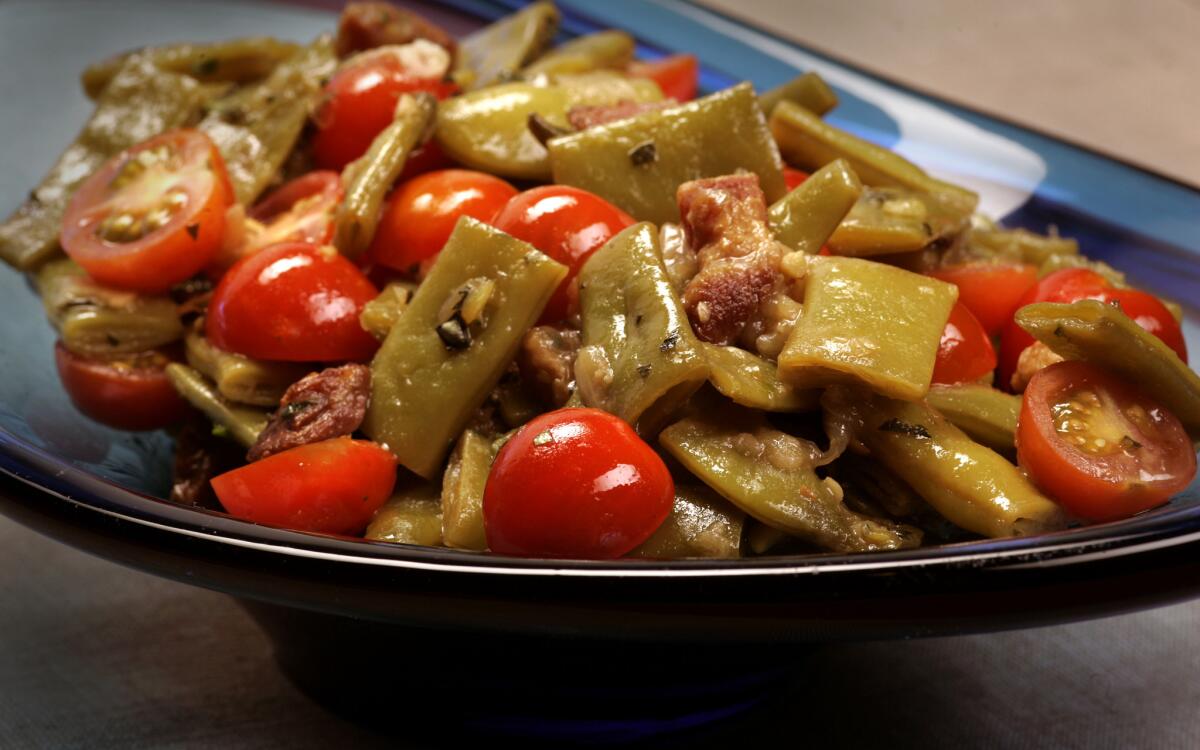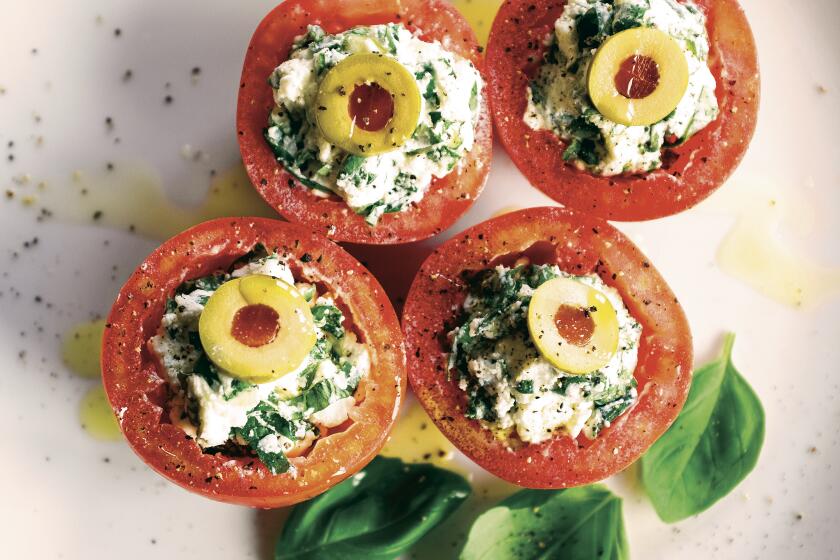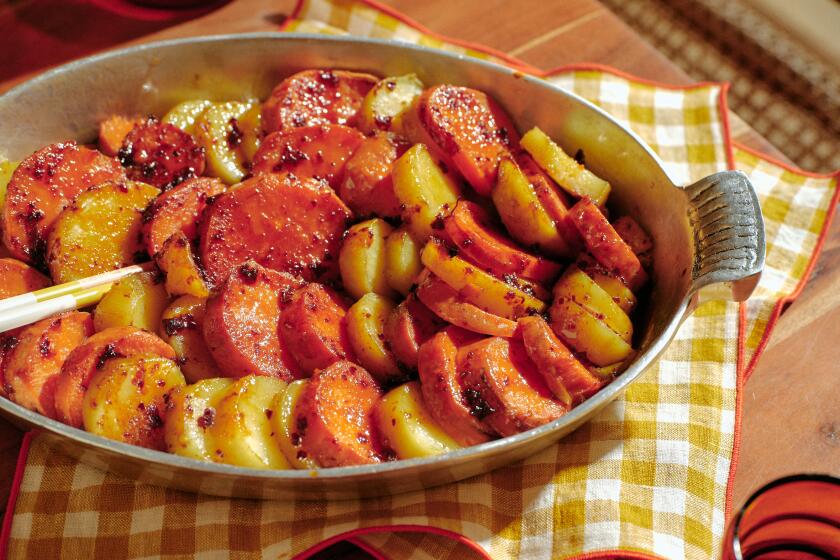Braised Romano beans with pancetta and cherry tomatoes

- Share via
Walk into a really hopping tapas bar in Spain or a swanky little osteria in Italy on a summer evening, and right at the front door you’re likely to be confronted with a long table full of bowls of vegetables. At first glance, you might think this is just one more sign that the end of the world is near: a salad bar in Europe?
But there’s one big difference: Most of the vegetables will have been cooked, and not just a little bit -- they’ll be almost limp. Well, actually, there’s another difference as well: They will be absolutely delicious.
While we modern cooks have made a cult of crispness since the introduction of nouvelle cuisine back in the 1970s, it pays to remember that sometimes it takes long cooking to bring out flavor. And while it may seem paradoxical, that’s especially true in the summertime.
Well-cooked vegetables have depth and richness. Even better, they are usually served at room temperature. Though some of their bright colors may have faded a bit, and though their crisp textures may have softened to the point that they flop lazily on a fork, this gives them a cool languor that is infinitely appealing when the weather is scorching.
The combination of all these things creates what can best be described as almost a negative heat. Come in from a hot, hectic day of running around, and a bowl of sweet braised zucchini -- cooked to the texture of butter, tart with lemon and perfumed with fresh herbs -- is almost as good as air conditioning.
You can serve these vegetables as the Spanish and Italians would, as appetizers (and the more the merrier -- mix and match vegetables to make an assortment of flavors).
Or you can complement them with nothing more than some sliced salame, prosciutto or chorizo, or a piece of good cheese. Add a glass of wine to make an elegant light dinner.
Under the common heading of “long-cooked vegetables,” there’s a wide variety of ingredients and techniques.
All sorts of vegetables can be grilled. Brush slices of eggplant and zucchini with olive oil and grill them over a medium-hot fire until they are tender. As they come off the grill, layer them on a platter with fresh herbs and sprinkle with olive oil and good vinegar.
You can do something similar by preparing the vegetables the way the Italians call in scapece. Fry eggplant, zucchini and even carrots in hot oil until they’re just brown, then dress them with vinegar and fresh herbs and set them aside so the flavors can marry.
Even more simply, grill whole bell peppers until their skins are shriveled and start to blacken. After they have cooled, peel away the papery skin and toss them with olive oil, sliced garlic and Sherry vinegar. A generous grating of black pepper gives a nice bottom to the flavor.
If you’re tired of grilled and fried eggplant, try steaming it. This sounds crazy, but it really works. Cut the eggplant (peeled or not, as you like) into chunks and steam it until the flesh is extremely tender (this will take only seven or eight minutes). The flavor stays pure and clean. After it’s cooked, toss the eggplant with minced garlic and herbs, olive oil and lemon juice.
Build a flavor base
Or roast tomatoes: Grind fresh bread cubes to crumbs with garlic and basil; slice off the top one-third of fresh tomatoes and squeeze out the seeds; jam the tomatoes tightly into a well-oiled baking dish; sprinkle with bread crumbs, drizzle with olive oil, and bake at 400 degrees until the crumbs are brown and crusty.
The tomatoes will shrink and shrivel in their own juices, concentrating the flavor and becoming almost custard-like in texture.
But probably my favorite method for fixing these well-cooked vegetables is braising. As the flesh softens, it not only creates more developed flavors, but also absorbs the flavors of the other ingredients that are cooked with it.
In general, vegetable braises proceed this way: Build a flavor base by saut?ing aromatics like onion and garlic in a little oil (butter tends to solidify and become grainy if the dish is served cool).
Next, add the main ingredient. Be sure to cut it in large pieces so they will cook long enough to develop flavor without falling apart. Cook briefly in the flavoring mixture and then add just a little water to start the braising (the vegetable will release plenty of its own moisture).
Finally, reduce the heat to low and continue cooking long enough to coax all of the flavor out of the dish. This can take as little as 20 minutes for a soft vegetable such as zucchini, or it can take as long as an hour for meaty Romano beans.
After a couple of decades of being overshadowed by twiggy haricots verts, these zaftig green beans seem to be making a comeback, at least in the Bay Area. On a recent trip, I ate them three days in a row. The first time was at lunch at Chez Panisse Caf? in Berkeley, simply braised with a little olive oil and lemon juice.
The next night at dinner at Delfina in San Francisco, there they were on the menu again, this time cooked longer in a chunky tomato sauce. Not wishing to buck a trend -- certainly not one as delicious as this -- the next night when I cooked dinner for some friends, I braised the beans with chunks of browned pancetta, finishing with chopped cherry tomatoes and basil.
As Romanos cook, their texture changes. At first, they are like fatter, denser green beans; a little longer and they turn rich and meaty. Braise them until the pods start to separate and fall apart, though, and they turn positively silky.
Brighten with mint
You can braise zucchini that way too; the texture becomes downright buttery. Brighten the rich, sweet flavor with mint and lemon and add some toasted pine nuts for crunch and contrast.
You can even braise bell peppers. I found this recipe in my friend Faith Heller Willinger’s new book “Adventures of an Italian Food Lover” -- she got it from her friend Carla Galli, a maker of artisanal aceto balsamico (this is the profound, aged, syrupy balsamic vinegar, not the thin sweet/sour industrial kind).
Befitting its majestic stature (and price), the aceto should be drizzled very sparingly as a condiment just before serving and after the peppers have cooled to avoid damaging the vinegar’s flavor. Using only a teaspoon will turn the dish from something delicious into something grand.
And if you can’t find a great aceto, this will still be very good if made with a top-quality Sherry vinegar or red wine vinegar.
You’ve probably noticed by now that some sort of acid -- vinegar or lemon juice -- is a prominent component of each of these dishes. That’s because without it, those luxurious textures and rich flavors can seem unctuous.
The acidity gives the dish the backbone it needs to avoid feeling flat and heavy.
Because the acidity is so important, be sure to taste and add more, if necessary, just before serving. Particularly in these dishes, acidity is every bit as important a seasoning as salt.
And because the vegetables are served at room temperature, they may require a little more seasoning than you might expect.
Remember that heat exaggerates flavor, whereas cold minimizes it. What might taste perfectly seasoned right out of the pan may need a little boost by the time it is ready to serve.
The good news, though, is that except for that bit of tweaking, these dishes can be made well in advance of dinner. Fix them in the morning, when the kitchen is cool (or even the night before). The flavors will improve as they stand.
Just be sure to bring them to room temperature before serving. When it comes to well-cooked vegetables, it’s better to be cool than to be cold.
Unroll the pancetta and cut it into pieces about one-half-inch long. Heat the olive oil in a large saut? pan over medium-high heat. When the oil is hot, add the pancetta and cook until the meat is well-browned and has rendered much of its fat, about 8 minutes.
Pour off all but about 2 tablespoons of the fat, return the pan to the heat and add the onions. Cook until the onions are tender, about 3 minutes. Add the garlic and the Romano beans and stir them with the onions and pancetta. Add the salt and three-fourths cup water and reduce the heat to medium.
Cover and cook, stirring occasionally, until the beans are silky in texture and extremely flavorful, about 45 minutes. If the mixture begins to cook dry, add a little more water.
When the beans are cooked, remove the lid and cook long enough to evaporate most of the remaining water, about 5 minutes.
Reduce the heat to low and add the cherry tomatoes. Cook until they are warmed through. Serve either warm or at room temperature, first stirring in the basil and tasting and correcting the seasoning.
Get our Cooking newsletter
Get a taste of Los Angeles — and the world — with recipes and kitchen tricks from the L.A. Times’ Cooking newsletter.
You may occasionally receive promotional content from the Los Angeles Times.
















